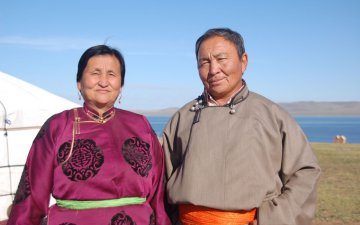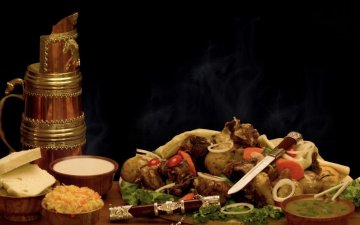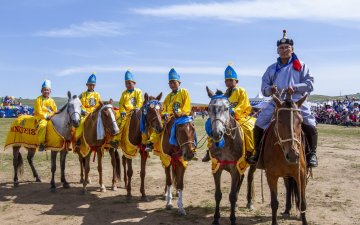Mongolians used to organize Naadam festivals to celebrate rituals such as holding a great Khuraldai (meeting of rulers), enthroning a king, worshiping the sky or going to war. Now Naadam is celebrated every year to commemorate the anniversary of the National Liberation Revolution, the establishment of the first independent state of Mongolian nomads, as well as the Great Mongol Empire.
The Nine White Banners of the State (Turiin Yusun Khult Tsagaan Tug), which hang in the Government Palace and symbolize independence and sovereignty, are placed in the center of the Central Stadium during the festival. The chant and cheer of Mongolians coming from every corner of the country to welcome the banners and enjoy the festival make this celebration especially majestic. While there is only one national Naadam held in Ulaanbaatar, there are also many smaller festivals held in each province and city throughout the month of July. The festival traditionally celebrates 'the three games of men': archery, wrestling and horse racing. There are also highly competitive ankle bone tournaments during the festival. Though directly translated to the games of men, Mongolian women do compete in archery and horse riding. Wrestling not only tests the strength of the wrestlers, but also teaches the athletes to handle both victory and defeat gracefully. Losers of a wrestling match must perform the ritual by taking off his ‘zodog’ (top) and go under the right arm of the winner honoring the victory of his opponent. The winner runs towards the state flag and performs a kind of dance as a sign of his victory. A dance-like ritual is performed before the fight by both wrestlers and afterwards by the winner to show respect to the audience while revealing strength. The wrestlers push their chest forward, stretching their arms above their shoulders towards the sky and slightly bending their knees looking to the right and left. This dance replicates giant falcons majestically landing from above. Archery is said to require an orderly mind and precision. Many Mongolians believe that horse racing, which features races up to 27 kilometers long, brings good fortune. Ankle bone shooting builds endurance and stamina. Winners of the horse races and wrestling matches are praised with traditional chants and are awarded titles and medals. The festival is a time of great celebration and Mongolians dress up for the part – donning their specially designed deels and ornaments.
Wrestling
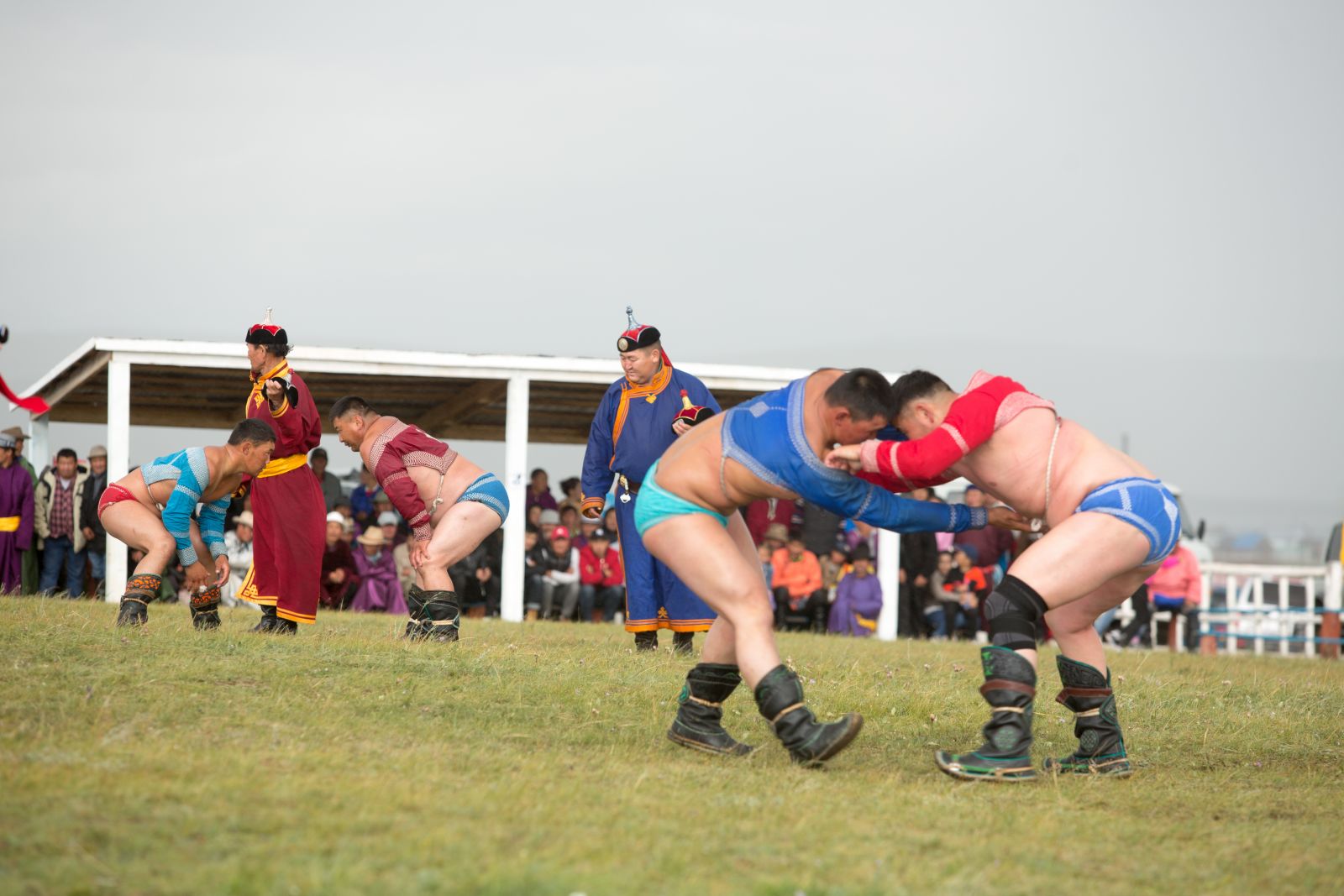
Wrestling is the most popular of all Mongolian sports. It is the highlight of the Three Games of Man. Historians claim that Mongolian wrestling originated some 7,000 years ago. The technique and rituals are distinctly national. There are no weight categories or age limits. Wrestlers wear leather boots, a very small tight-fitting loincloth, a pair of sleeves which meet across the back, the back of the shoulder blades like a small bolero jacket, and a pointed cap of velvet.
Contestants take the field leaping and dancing, flapping their arms in imitation of an eagle, each with an attendant herald.
The aim of the sport is to force your opponent off-balance and make him touch the ground with his elbow or his knee.
The loser walks under one raised arm of the winner as a sign of respect, and unties his vest, after which the victor, once more leaping and dancing, takes a turnaround the flag in the center of the field.
Traditionally, either 1,024 or 512 wrestlers enter the contest and nine rounds of one-on-one wrestling, one being eliminated from each bout. A wrestler who beats five opponents in succession is awarded the title of Republican Falcon; the winner of seven rounds is called Elephant. He who becomes champion by winning nine rounds is given the title Lion, and if he wins two years in row, he is called Giant. If a wrestler wins for a third time at Naadam, he adds National to his title, and if he wins again, he is styled Invincible. Tournament winners receive titles and various souvenirs, but their main gratification is the truly national popularity and fame they gain.
The wrestler’s jacket and briefs are the signs of strength. Later on, the costume of wrestlers became more elegant. At present wrestling costumes consists of a hat, zodog (jacket), shuudag (briefs), boots, stockings and boots’ bindings. The jacket and briefs afford a wrestler the ability to hold his opponent during the wrestling bout. The well-tailored jacket and briefs adapt themselves to the shape of wrestler’s brawny body. This tight costume affords a wrestler’s comfort to move. The wrestler wears an ancient hero’s helmet-shaped hat. It attests to the fact that the wrestling of Mongolia originated from among strong men who tested the brave deeds of ancient Mongolian warriors.
Mongolian wrestlers wear high-boots which keep their footing firmly and prevent their legs from slipping when wrestlers trick each other with their legs. They wear felt stockings which play a role in protecting their legs from injury; the stockings are stitched with auspicious ornaments, which add grace to the wrestler. The bindings of the wrestler’s boots are also kind of a grace to the wrestler.
Horse racing
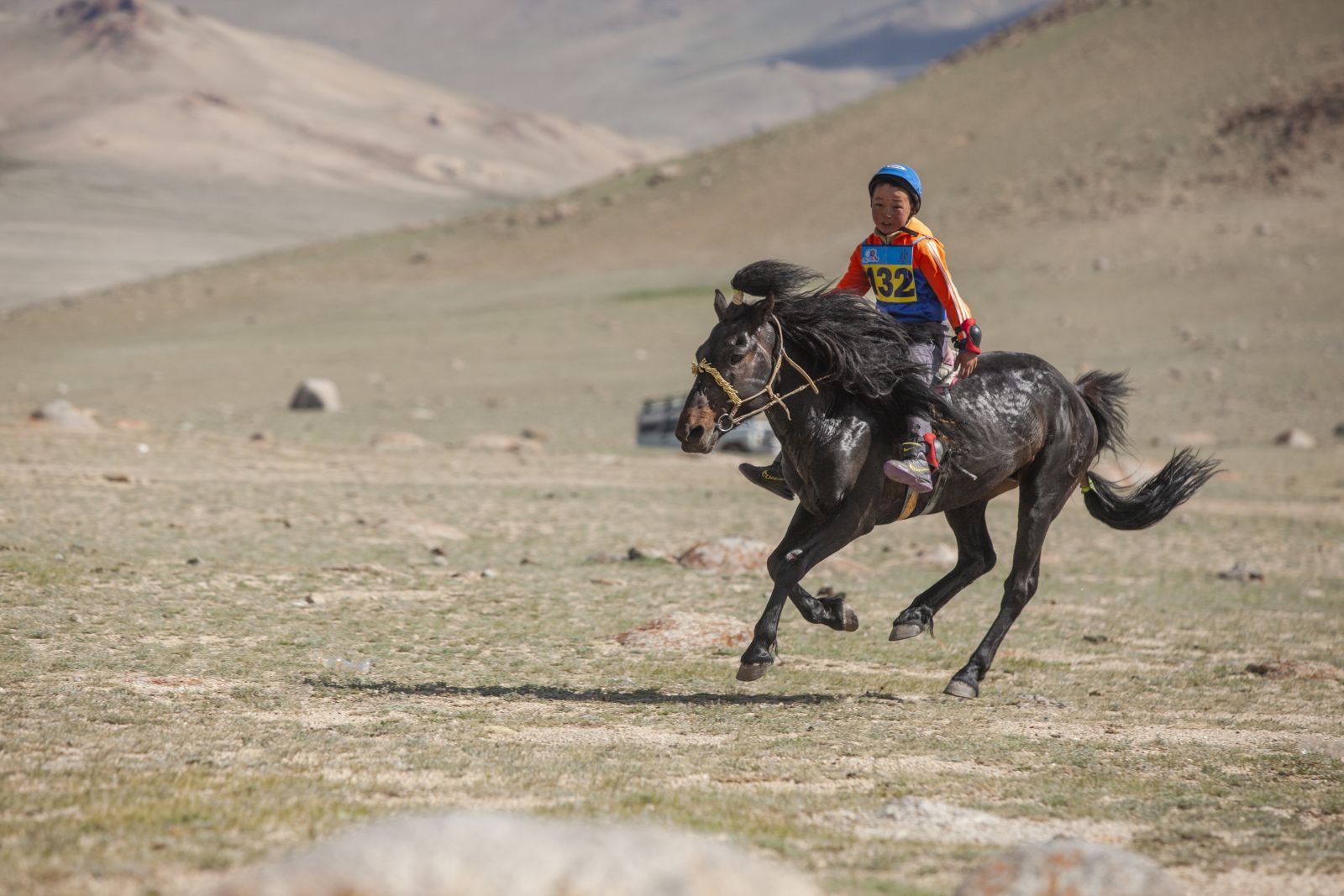
Jockeys of swift horses in general are children between 6 and 10 years old. Those child-jockeys wear ample, light and vivid-coloured dresses. The patterns of wheels, wish-fulfilling signs, five stars or signs of luck or figures of birds or butterflies are stitched onto the front or back of the jockey’s shirt, and onto the breeches or onto the front of their cap. There are marks that symbolize prowess, fame and promptness. In another word, a figure of a butterfly is a symbol of lightness. The bird symbolizes the swiftness of horses.
Archery

The shooting of bows and arrows has traversed many centuries. In these competitions, posts were driven into the ground in a row. Skin-balls were hung from each post. The archer, who rode on his horse at full gallop, shot every hanging skin-ball without missing. This was called ‘ball-shooting’.
The sheepskin or cowhide was stretched out. Each archer shoots at this stretched skin or hides with twenty arrows. Then the score was reckoned. It was called Sarampai kharvakh (thin worn skin shooting). Eight sheep skins were joined. The figure of a human being was drawn onto the middle of this stretched skin, which was stretched on the square frame. This figure was called the ‘enemy’. Archers shot twenty arrows at it from behind a hill or ravine. The distance of shooting was forty feet. Whoever got more scores at shooting was the winner. It was called ‘enemy shooting’. The distance of the contemporary sport of archery is 45 feet or 75-80 meters.
We make shooting targets by weaving leather strips into a tub-shape. There are two forms of shooting targets. One is a walled target, another is an individual target. The wall target is the arrangement of targets in a stack. The individual target is the arrangement of targets in row.
The archers can use only blunted arrows. Then two shooting teams alternately shoot and test their skills. There are two forms of shooting. One is an individual; the other is a team sport. The amount of shooting for individuals or teams is fixed. Then the result is reckoned.
New articles
9 Reasons to Travel to Mongolia
- It's the home of living nomadic culture
- The vast, untouched steppe
Deel (traditional clothing)
The traditional mongolian outfit, or Deel, is primarily practical. It warms a horse rider’s back and the long coat protects the rider’s legs and knees from the cold.
Mongolian Food and Beverages
Mongolian food is certainly not very well known. High in meat and flour, and with lots of added dairy products.
Traditional Naadam Festival
Mongolians used to organize Naadam festivals to celebrate rituals such as holding a great Khuraldai (meeting of rulers), enthroning a king, worshiping the sky or going to war.

